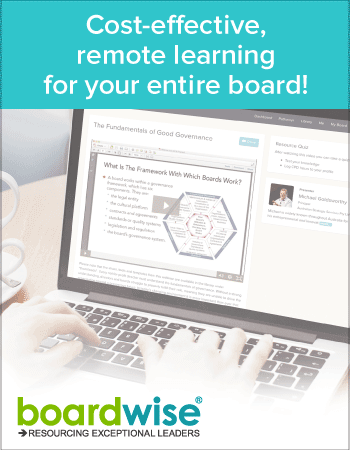technology
How to run remote board meetings securely and effectively
Published: September 15, 2020
Read Time: 10 minutes

- Remote meetings present technological, social, legal and security challenges. But they also offer convenience, an opportunity to expand your board’s membership and a catalyst to evaluate the effectiveness of your meetings.
- Access to technology and digital literacy are vital to successful virtual meetings. Provide any skills training board members need to confidently participate in video or conference calls.
- Security is a particular concern with remote meetings, so review your company’s security protocols and make sure you understand any risks involved with the technology you use.
Your board of directors takes on a vital job during a crisis: charting a path toward the new normal. They have to support the organisation through today’s challenges — the COVID-19 pandemic — and continue moving the organisation forward so it’s ready to resume activity after the immediate crisis has passed.
That means you have to keep your board meetings running — albeit virtually. In fact, you may have to meet more often as you work through unprecedented disruptions and challenges for the organisation.
Virtual meetings for not-for-profit or company boards present unique technological, legal and security issues you’ll need to address to keep the board running smoothly through social distancing orders.
Consult your constitution
Check your constitution’s governing documents to make sure you don’t face restrictions against holding remote meetings or passing a resolution remotely. If it contains provisions that could cause an issue — especially if you don’t have a choice but to meet remotely — speak to a lawyer about updating the constitution.
If your organisation has updated its constitution within the past decade, it probably allows for remote meetings. Most regulations allow for remote meetings explicitly or defer to the organisation’s constitution.
Benefits of remote meetings
If you prepare carefully, remote meetings can have significant benefits. This was true before the COVID-19 pandemic, but social distancing has forced many organisations to go remote, and this is an opportunity to learn about those benefits, which might include:
- Expanded board member or director recruitment. Not restricting board members to a location lets you draw from a wider pool of candidates. Remote meetings let members participate from anywhere.
- Convenience for attendees. Eliminating travel and associated costs makes it easier for board members to attend meetings.
- Increased meeting cadence. More convenient meetings means you could hold them more often. This could help you focus each meeting more in-depth and get more done.
- Improved meeting processes. The chair has to run remote meetings a little more strictly than in-person meetings. This can force the board to better adhere to meeting protocol.
- Additional opportunities for improvement. Shifting how you conduct meetings gives you a chance to change what hasn’t been working.
How to run a smooth remote board meeting
There are certainly some potential negative consequences of running meetings remotely that you don’t have to worry about with in-person meetings. To keep things running smoothly during this crisis — and to potentially enjoy the benefits of remote meetings in the future — consider these issues before running a remote board meeting.
Prepare extensively
Remote board meetings could present these unique challenges:
- Technology and network problems.
- Late attendees.
- Not sending the agenda far enough in advance.
- Security issues.
- Attendees multitasking.
- No post-meeting follow-up.
- Poor location choice by participants.
- Short notice of meeting.
Take these steps to prepare carefully and head off any problems:
- Set and respect meeting times. State a start and end time for meetings, and honor them. Consider network capacity when scheduling meetings. Increased internet usage could cause a lag in your video meeting, so avoid high-volume times.
- Give staff extra time to prepare. Give more notice than usual to anyone preparing documents, information or presentations for the meeting. They may still be figuring out how to work remotely and manage workloads with family responsibilities from home.
- Provide a point of contact. When you send reminders to members to join the meeting, include a contact detail list for everyone on the board or at least a point of contact they can get in touch with if they’re having trouble connecting.
- Test meeting software before the meeting. If the technology is new to anyone, run tests, possibly even a mock meeting, to get everyone comfortable. This lets you troubleshoot issues without stalling the meeting, and it also lets you experiment to find the tools or format that work best for your group.
- Put fewer items on the agenda. Tech issues can take up time in meetings, and attention spans are shorter for looking at a screen, so don’t expect to get through as much as you would in an in-person meeting.
Make a list of protocols and meeting etiquette
Generally, meeting protocols and basic etiquette observed in your normal meetings will apply to remote meetings. But it’s a good idea to make a list for directors to refer to ahead of a virtual meeting.
Some protocols to consider:
- Reiterate that meetings require respect and civility.
- Respect others’ time by being prepared and sticking to the agenda.
- Be present, and don’t multitask during calls.
- The chair should direct the meeting by stating who should speak when (to keep anyone from talking over another).
- Outline how you’ll use the meeting platform’s technology, such as video, audio, chat, hand raising and polls.
- Encourage participants to consider their background noise and visual space to avoid distractions.
- Everyone should introduce themselves when they enter a meeting, especially on a phone call but also in video calls in case everyone doesn’t notice you signing on.
This is also a good time to update your board’s policies to cover remote meeting issues, including:
- The conferencing technology you’ll use.
- How participants connect (e.g. via virtual private network).
- Whether directors can participate on personal devices or are required to use organisation-issued devices.
- Whether the meeting can be recorded.
- Where participants should be located (e.g. not in a public space or shared room) to maintain confidentiality.
- Directors should verify the identity of people in the meeting.
Ensure access and digital literacy
Ensuring everyone can participate as necessary requires two things: technology access and digital literacy.
Technology access: The organisation should provide the account access and software necessary for board members to participate in a meeting through agreed-upon technology. Don’t rely on members to purchase necessary subscriptions or software.
Digital literacy: Lack of comfort with the technology is a barrier to full engagement in the meeting, so it’s important to help members feel confident with the tools you use. Invest time or money into training board members, and running test meetings to help members become comfortable with the technology.
Add water cooler talk to the agenda
Meeting remotely means missing the post-meeting time when board members could linger and catch up with each other or discuss what happened in the meeting.
You can facilitate a similar atmosphere by building some casual conversation into the meeting agenda. Here are some ideas:
- Allow one minute per person at the top of the meeting for a personal check in.
- Assign 10 minutes at the end of the meeting for people to chime in casually. This is a good time to get their feedback on the meeting format, as well, so you can adjust going forward.
- Schedule separate casual board catch-up sessions, where directors can meet to check in and chat without a formal agenda.
Facilitate accurate minute taking
Remote meetings make minute taking especially difficult because of the potential for videos to lag or audio to drop out. The chair should be cognizant of the minute-taker and clarify or reiterate where necessary.
The minutes for remote meetings should also confirm that all legal and constitutional requirements for the meeting have been fulfilled.
Incorporate technology in small steps
It’s easy to get over-excited about all the things technology can do for your board. But it could be overwhelming for some members if you introduce everything at once.
Instead, introduce new technologies one step at a time. For example, virtual meeting apps might give you the option to run polls, raise hands, incorporate virtual backgrounds or change the screen view. Don’t expect participants to learn all of these features in the first meeting, but incorporate them over time.
You also may not need tools with all the bells and whistles. Choose the solution that best suits your board’s need, budget and digital literacy levels. Fewer moving parts during a meeting means less chance of disruption, so don’t opt in to more than you need. As your board members become more comfortable with technology consider adding more technology tools, such as a board portal, to compliment other tools you might be using and improve your boards efficiency.
Security for remote meetings
Remote meetings pose security challenges you don’t face with in-person meetings, but confidentiality is still just as important. Here are some steps you can take to reduce security issues:
- Brief meeting assistants on confidentiality. Remote meetings might require attendees who weren’t previously included in board meetings, such as an IT person to help run the meeting. They should be briefed on and bound by confidentiality just as directors are.
- Know who’s in the meeting. Attendees should access your meetings through private links or with a password, but keep an eye on who joins the meeting in case anyone has gotten public access.
- Don’t share more than you need to. Limit what’s visible if you send video or share your screen to avoid broadcasting sensitive or confidential information. Use virtual backgrounds to block what’s behind you, and locate yourself so no one can walk by and see what’s on your screen.
- Don’t record meetings. You shouldn’t record board meetings in general (that’s why minutes are taken), but remote technology makes it more vital. The platform might be able to claim ownership of your recording, or an unauthorized person could obtain it digitally.
- Don’t share meeting links publicly. Keep meeting links out of public spaces, like social media; and company spaces that are accessible to all staff, such as a company calendar or chat app.
- Add anti-virus endpoint protection to every device. These are affordable and can protect company-owned devices from being attacked by malware.
- Set up two-factor authentication. On company email and other systems where members have to log in, set up two-factor authentication for added security. It requires a second step, such as a code sent via text, for members to log in.
- Use a secure system for file-sharing. Don’t send sensitive files through email. Instead use a secure cloud system like Firefox Send, which offers encryption, password protection and expiration for free.
- Set up a password manager for the company. A software like Dashlane or LastPass lets you create unique, secure passwords for every online service. You can share passwords with other members without revealing them.
- Install the latest security updates. Before working remotely, check that you’ve accepted any pending security updates on company computers or tools.
- Note any information remote-work tools collect. Which data do they collect from your users, and what do they do with it? Where they store data could be important, too, if your organisation has set requirements for data storage.
After the meeting
Adopting a new format, as well as new technology, needs to be iterative. Get feedback from board members following each meeting to evaluate the experience and adjust as needed.
Ask participants to rate:
- The overall experience of the meeting.
- The effectiveness of the agenda.
- The direction of the chair.
- How well everyone prepared.
Get the feedback in time to make necessary adjustments before the next meeting.
This article is based on the webinar, “Effective Remote Board Meetings,” by Raphael Goldsworthy. Watch this webinar and others as part of a Boardwise membership.
Share this Article
Recommended Reading
Recommended Viewing
Author
- About
-
Better Boards connects the leaders of Australasian non-profit organisations to the knowledge and networks necessary to grow and develop their leadership skills and build a strong governance framework for their organisation.
Found this article useful or informative?
Join 5,000+ not-for-profit & for-purpose directors receiving the latest insights on governance and leadership.
Receive a free e-book on improving your board decisions when you subscribe.
Unsubscribe anytime. We care about your privacy - read our Privacy Policy .










